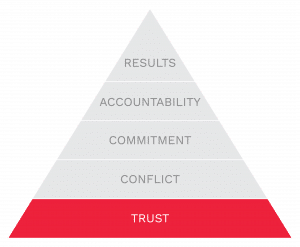
Team building
Teams are built by their leaders and their members. The most productive and affirmative teams do not take their relationships or their culture for granted, but rather build them consciously. They attend to the needs of their team. Team members build their own skills and offer those in support of each other and the team. Team leaders model and promote good team behaviors. Organizations consider teamwork skills when evaluating employees or considering them for promotions.

Teamwork was the skill 32 percent of employers chose as most important to them in Robert Half’s research for their 2023 Salary Guide. Many of us are watching companies like Dropbox and Atlassian with their “Team Anywhere” and “virtual first” approaches to work. We’ve learned that remote collaboration requires more than working technologies. We’re wondering what makes teams successful.
Employees need to develop their teamwork skills. And managers must learn how to get the most out of the teams they lead. Certain team dynamics will always be critical, no matter where teams collaborate. This article covers four areas where teams can look for improvement.
Hybrid & virtual teams
Managers must find new ways to build team culture and create new practices to make flexible work patterns sustainable and functional.
Communication
With so much work done by teams in an organization, it’s vital that teams strive for good communication.
Trust
Do you want to increase job satisfaction, reduce stress, and increase productivity? Improving the level of trust on your teams can do just that.
Managing conflict
Learning to recognize various forms of conflict will help managers address conflict when it inevitably arises.
Commitment & accountability
Confronting issues around commitment and accountability of a team’s members can be the hardest work the team undertakes—and the most productive and rewarding.
Communication
One of the most indispensable skill sets for individuals and team leads is communication. Failures here can decrease creativity, decrease productivity, impair culture, cause deadlines to be missed, and more.
Individual communication skills
Many of us gained practice writing papers, giving a presentation, and working in groups at school. However, it’s less likely we were taught skills like how to write concise emails, provide clear step-by-step instructions, use plain language instead of jargon, give actionable feedback, present ourselves well on video, or engage in productive conflict. Employers may not be able to hire for all these skills, but they can be taught.
In addition to the 7 Cs of writing (clear, concise, concrete, correct, coherent, complete, and credible or courteous), I suggest team members consider these elements of communication as well:
- Listening: Takes time to understand and ask appropriate questions without interrupting; accepts constructive feedback.
- Sharing: Knows how to discern what information should be shared with team members or others and how best to reach intended recipients.
- Using appropriate technologies: Changes forms of communication based on the receptivity or preferences of their audience.
- Showing respect: Honors the needs, practices, backgrounds, views, experience, and interests of other team members. Acknowledges the skills, experience, knowledge, creativity, and contributions of other team members.
- Offering actionable feedback: Provides feedback that is timely, constructive, and specific.
- Addressing communication roadblocks: Speaks up when clarity is lacking, when conflict arises, or when other barriers are hit. Offers solutions.
Team lead communication skills
The leader of a team has even more responsibility for communication. The team lead is responsible for the following communication tasks:
- Defining and clarifying roles and responsibilities for each team member.
- Setting standards, along with the team, for information-sharing processes.
- Managing conflicts that the team can’t take care of on its own.
- Ensuring that their own actions reflect their words.
- Candidly overcommunicating during times of change, confusion, or crisis.
- Setting formal meeting agendas.
- Soliciting feedback from the team and offering constructive feedback to members.
- Ensuring the team has informal time together to build trusting relationships.
- Celebrating the team.
- Sharing information appropriately and keeping confidentiality when asked.
- Reporting on team results.
- Helping the team members understand the impact of their work.

Trust
Trust is a central part of all human relationships, including among team members. Good communication skills can build trust. Through clear, timely, and respectful communication, the rest of the team learns that we can be trusted to follow through on our commitments. Through admitting our mistakes, they learn that we’re willing to take responsibility.
In Patrick Lencioni’s model of teams, trust is the foundation upon which cohesion is built. Trust is also a component of Amy Edmundson’s concept of psychological safety—a strong predictor of team effectiveness. Trust is about the beliefs we have about another person. Psychological safety is more focused on how you think others on the team perceive you. Both trust and safety must be high to ensure that teams are more likely to share ideas, reveal and discuss mistakes, ask for and receive feedback, take reasonable risks, and confront work-life issues.
Effective teams possess a high degree of interdependence—members must rely upon each other to achieve collective results. Members who understand what is expected of them and others, and who know that they can depend upon their teammates, will perform better and enjoy themselves more while working. They will be more committed to the team and find it easier to accept both personal responsibilities and shared accountability for results.
Conflict
Great teams aren’t devoid of conflict. They are willing to address it and sometimes even seek it out. They understand that conflict can be productive.
Teams can discuss how they have handled conflicts in the past and how they want to handle conflicts in the future. Having this discussion outside a real conflict can provide guidance around expected behaviors and reassurance that conflict is normal. It makes it less likely that poor behavior during conflict will be accepted. It makes it more likely that real solutions will be found.
On healthy teams, members express their differing opinions in order to reach the best solution. Although team members disagree, everyone’s ideas can be heard and respected. Consensus isn’t always necessary, but getting multiple perspectives is.
Sometimes productive conflict doesn’t feel like conflict; it feels like surfacing the best idea or best action. A high level of trust and psychological safety make it more likely that conflict will be seen in this way.
Team members who have good communication skills, high levels of self-awareness, and high emotional intelligence will find it easier to engage in productive conflict. They are also less likely to allow destructive conflicts to linger or to remain on the team if they aren’t addressed.
Great teams aren’t devoid of conflict. Sometimes, they even seek it out.
Culture
A team’s culture isn’t defined by an organization’s mission or values. It’s defined by the values, beliefs, attitudes, and behaviors shared by the members of the team. It’s the way the team does things, from how they engage in difficult conversions to how they celebrate success. And each person builds this culture with the others on the team.
Even though healthy cultures can differ, signs of good team cultures often include the following:
- Members are willing to help each other out and are focused on team goals as much as their individual ones.
- When times are good, the team members feel like they are winning together. When times are tough, they are determined to collectively face their challenges.
- The team is resilient and able to adapt to changes.
- Members are committed to the team and the team’s reason for being.
- Team members hold each other accountable for results.
- Members understand each other’s strengths and talents.
- They have strong and positive working relationships with each other.
- There is a lack of favoritism and politicking.
- Together they produce a safe and creative environment.
A team’s culture isn’t defined by an organization’s mission or values.
When teams begin their meetings with a good question, it brings everyone’s attention to the present moment and to the group.
The five behaviors of a cohesive team—trust, conflict, commitment, accountability, and results—remain the same. But in the virtual environment and during times of crisis, they can show up in different ways. That means leaders must show up in different ways, too.
Great communication is the main tactic teams use to build up each pillar of the five behaviors of a cohesive team. Here are tips for your teams and team leaders.
